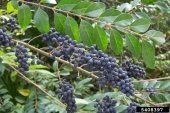When you say "hit the jackpot" I assume you mean a big return fast without a huge investment of time and energy. Not possible, I'm afraid. There are ways to make money from a forest while working responsibly with nature, but I'm afraid they're just going to take time and effort, and the return will not be a huge one.
The one way I can think to make some fast cash with a stretch of woodland would be to lease it to hunters during hunting season. Kind of depends on how big an acreage you have, if you have any houses bordering the property that would be hit by a stray bullet, and if any pastures border your property (a big brown calf or a 6 month old filly can look like a deer when views through a screen of brush--hunters have been known to shoot at what they think is a deer only to run to their kill and find they were near the edge of the woods and hit something NOT a deer.) You would have to make clear that the hunting party was not to nail makeshift stands to the trees and had to police their brass and trash, as well as sign waivers of liability so that they could not sue you for any accidents. Also, it would have to be made clear what dates they had reserved the property, if you wanted to rent to another party later, so that you'd not have more than one group shooting on the same days unaware of one another. Considering that deer season has archery, black powder, and rifle seasons in fall, and that there are also 2 turkey seasons, and squirrel season, it would be possible to make a bit of money there. (Arrows don't go as far as bullets, so a smaller acreage could support archery hunting when firearm hunting isn't possible.)
If you are in an area afflicted with feral pigs (an invasive and destructive and flat out mean critter) you might be able to make an arrangement with a person or 2 to pay a small fee to set up pig traps--they get to subsidize their grocery bill with organic free range meat, you get a small fee and get rid of a pest at the same time.
Other than that, Black walnuts trees produce large crops and also support certain groups of wildlife, as do shagbark hickory trees; black walnut wood is also valuable--takes about 10 years for a BW to bear nuts, and 15-30 more to reach the size for a good wood harvest, so it would be 10 years before you got a return from seed grown trees.
Pawpaws are a good tree for understory growth and they do tolerate the presence of BW trees. The fruit is rather delicate for shipping, though it does have quite a bit of demand in some areas. Mine, which are seed grown, are about 6 years old and I'm hoping to see blooms on them for the first time this spring. Container grown grafted varieties are available and would bear in a few years.
Native plums are a good plant to market as a wildlife feeder and an erosion control plant. The plants grow fast and then begin to sucker from the root. The suckers can be dug when young, potted up and sold after they develop some roots of their own. Fair bit of work there, but it does work with the plants natural tendencies and promotes good stewardship of the land.
Ginseng is a highly desirable medicinal that grows wild in the forests, and it is possible to seed hillsides with it, though the best and most profitable specimens are several years old, and the seed can take a couple years to germinate.
In all of this, you do have to factor in your time and efforts (planting, maintaining, harvesting) as well as advertising. With the rent to hunt option (if possible in your situation), you would have to clean up anything the hunters left behind (you could add a clean up deposit to be returned if they leave the property tidy). Good luck.








